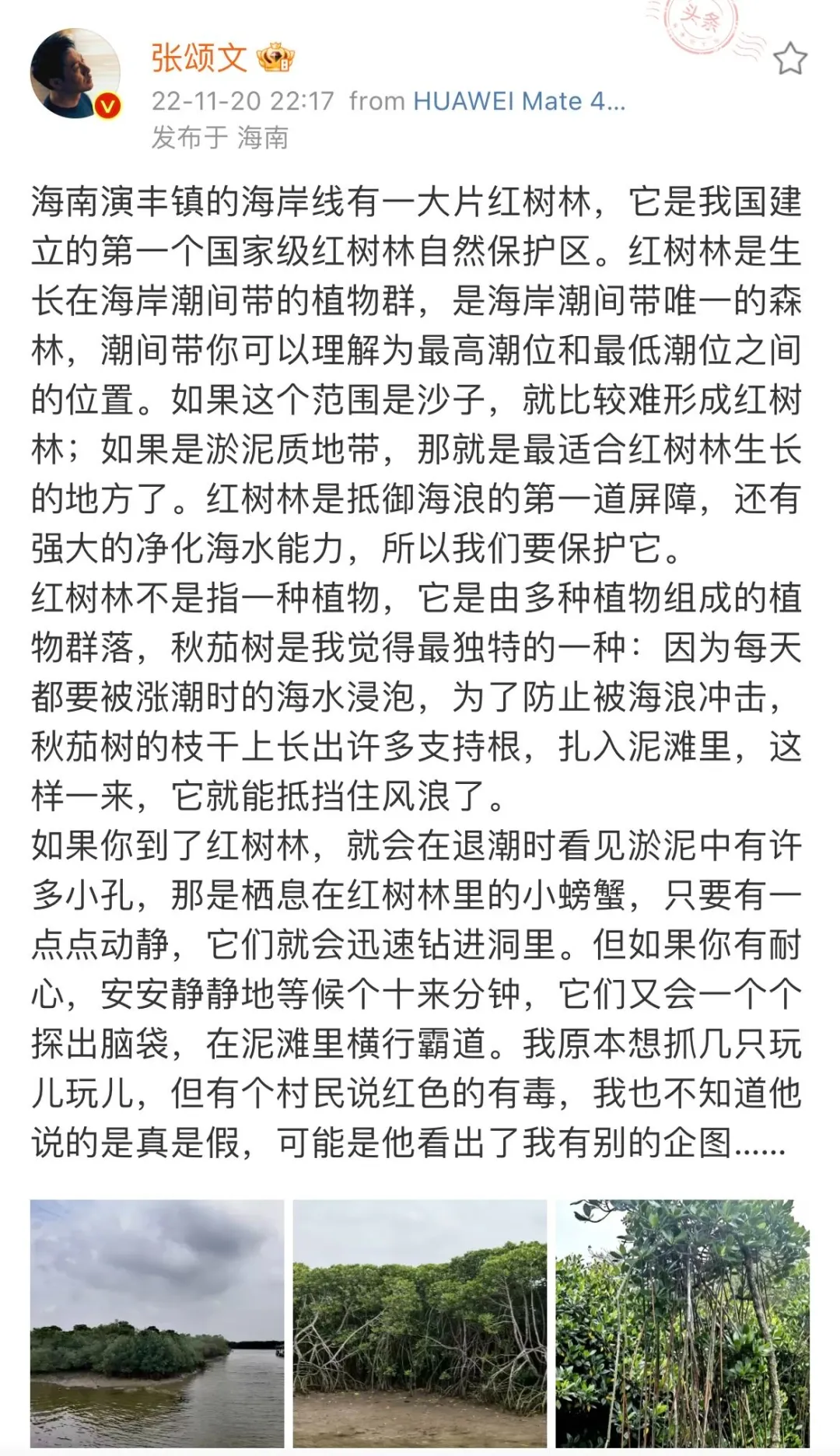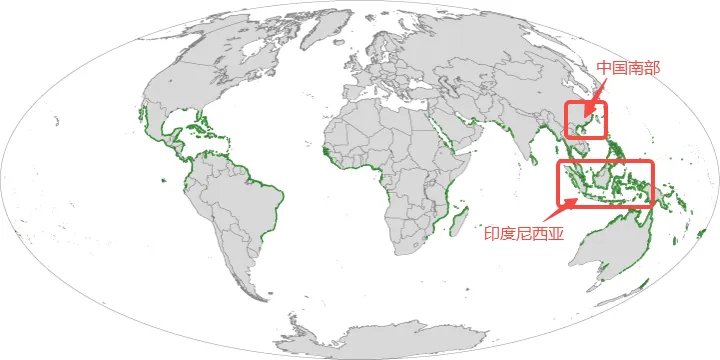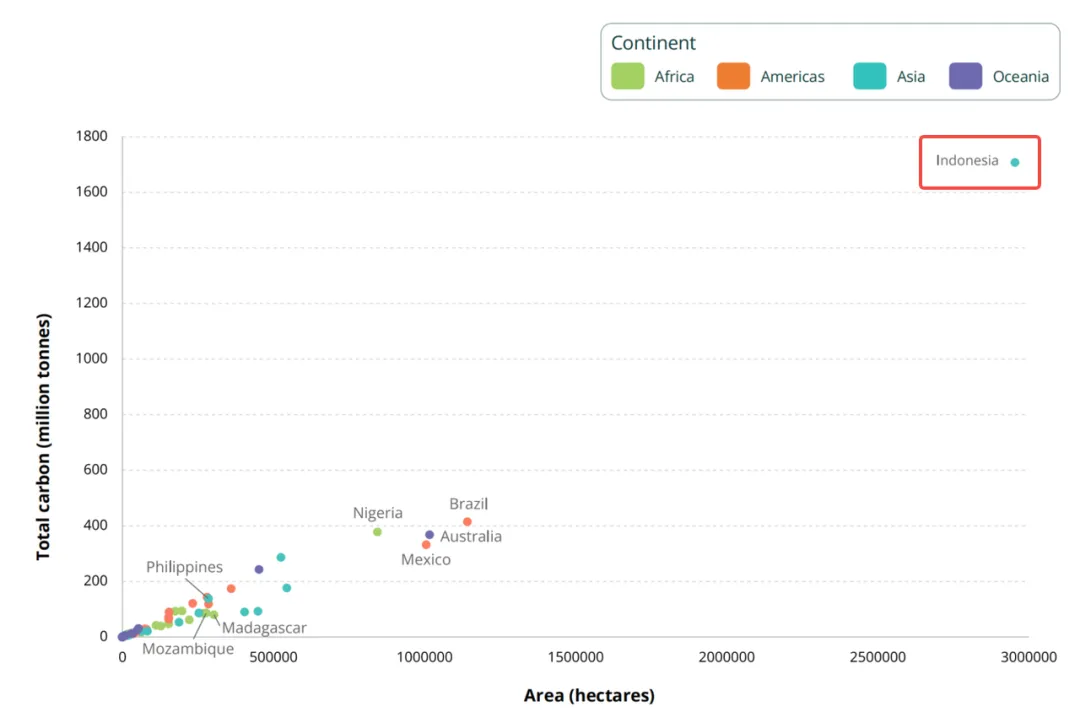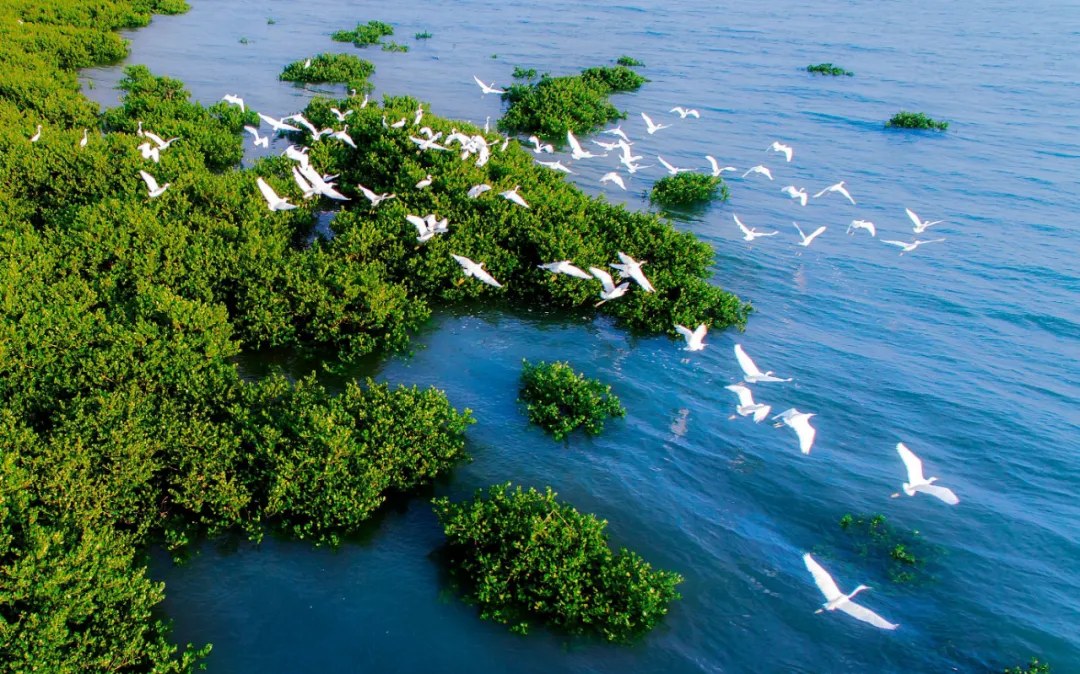Research shows that if just 1% of mangrove forests were destroyed, it would result in the release of approximately 230 million tons of greenhouse gases into the atmosphere, equivalent to the carbon emissions produced by 49 million vehicles (seven times the total number of cars in Beijing) driving normally for one year.
The popularity of the TV series "Raging Fire" has also brought increasing attention to its lead actor, Zhang Songwen, who plays the character Gao Qiqiang. While browsing through Teacher Zhang Songwen's Weibo, one particular post caught my eye.

It turns out that Teacher Zhang Songwen is also very interested in mangroves! Last November, after visiting the mangrove forest in Yanfeng Town, Hainan, Teacher Zhang wrote a long reflection. Besides this, Teacher Zhang has also left footprints in the mangrove forests of Taizhou and Shenzhen.
If a place can pique the curiosity of even someone like "Gao Qiqiang," wouldn't you want to delve deeper into it? Let's explore the wonders of mangroves together!
01 How Red Are Mangroves?
Despite being covered in green leaves, why are they called mangroves? This is a question that often arises upon first encountering them.
Mangroves, though not red on the outside, have a red interior. This is because plants in the mangrove family contain large amounts of tannins (an organic compound found abundantly in red wine). When tannins oxidize in the air, the branches and trunks they adhere to turn reddish-brown.
Mangrove plants form unique evergreen shrubs or small trees in tropical and subtropical bay and river mouth mudflats. They grow in intertidal zones where land meets sea, forming a special ecosystem that bridges terrestrial and marine environments, characterized by well-developed root systems capable of thriving in seawater.
Mangroves are widely distributed across 124 countries and regions in tropical and subtropical areas globally. In China, mangroves are mainly found in Hainan Island, Guangxi, Guangdong, and Fujian provinces.
Among these, national-level nature reserves for mangroves have been established in places like Shan Kou in Guangxi, Zhangjiangkou in Fujian, Zhanjiang and Shenzhen in Guangdong, and Taishan Town in Jiangmen, Guangdong. The Dongzhaigang National Nature Reserve in Yanfeng Town, Haikou, Hainan, is where Teacher Zhang Songwen visited previously.

02 Mangroves: Guardians of the Coastline
"Mangroves are the first line of defense against waves and have strong capabilities to purify seawater; therefore, we must protect them."
As Teacher Zhang Songwen noted, mangroves use their intricate and extensive root systems to effectively trap sediments carried from the land, reducing sediment content in coastal waters. Their dense and tall branches act like green fortresses, effectively resisting wind and wave attacks.
Mangroves also have a complete ecological cycle, nurturing mangrove plants, semi-mangrove plants, mangrove companion plants, and aquatic phytoplankton, making them one of the most biodiverse and productive marine ecosystems.
Besides protecting coastlines, mangroves serve another crucial function: blue carbon.
03 Blue Carbon Stars: Mangroves
Mangroves can absorb carbon dioxide, regulate climate, resist tsunamis and typhoons, and help purify seawater quality, demonstrating a powerful carbon sequestration ability far beyond that of terrestrial forests. Compared to terrestrial forests, mangroves can sequester 3 to 4 times more carbon, earning them the title of "Blue Carbon Stars."
Blue carbon, also known as oceanic carbon sinks, differs from green carbon, which uses photosynthesis in green plants to absorb carbon dioxide. Blue carbon utilizes ocean activities and marine organisms to absorb atmospheric CO2, with 50-90% of the absorbed carbon stored in the soil, lasting much longer than carbon stored in vegetation biomass, potentially for thousands of years.
In September last year, the Ministry of Natural Resources approved and released the "Calculation Method for Marine Carbon Sinks," defining marine carbon sinks as "the processes, activities, and mechanisms by which mangroves, salt marshes, seagrass beds, phytoplankton, macroalgae, and shellfish absorb and store atmospheric CO2 from the air or seawater." Among these, mangroves, salt marshes, and seagrass beds are known as the three major coastal blue carbon ecosystems.
Salt marshes are widely found in mid-to-high latitude regions and are one of the most common wetland types in China. Seagrass beds, composed of flowering grass-like higher plants, form large, contiguous ecosystems that serve as habitats and important food chains for marine life, stabilizing the seabed and coastline. However, for coastal blue carbon, mangroves remain the most important.
Studies show that each acre (about 4,067 square meters) of mangroves can store between 50 to 220 tons of CO2 over its lifetime, and the world's mangroves can store over 24 million tons of CO2 annually. Despite occupying only 0.1% of the Earth's land area, mangroves account for 5% of the global total carbon sequestration.

From the above image, it is evident that Indonesia leads globally in both mangrove area and carbon storage. According to World Bank data, Indonesia's mangroves cover over 20% of the world's total mangrove area. However, since the 19th century, nearly 1 million hectares of mangroves have disappeared in Indonesia.
Mangroves' exceptional carbon sequestration ability is attributed to two key factors:
Firstly, mangroves have high productivity, and their underground parts remain in an anaerobic environment for long periods, slowing down the decomposition rate of roots and litter, thus accelerating carbon burial rates.
Secondly, most mangroves are located in sedimentary coastal estuaries, where upstream rivers and tidal actions bring large amounts of exogenous carbon, which is fixed and rapidly deposited in the underground parts.
04 Current Status of Mangrove Carbon Sink Projects
Given that mangroves have higher carbon sequestration capabilities than terrestrial forests, it is inevitable that carbon sink projects and trading would develop around them.
In March 2020, the Zhanjiang National Mangrove Nature Reserve in Guangdong Province initiated the "Zhanjiang Mangrove Afforestation Project." According to professional assessments, the planting of 380 hectares of mangroves within the reserve is expected to generate 160,000 tons of CO2 reductions between 2015 and 2055.
In April of the following year, the project was officially approved, becoming the world's first carbon sink project to meet both the Verified Carbon Standard (VCS) and the Climate, Community & Biodiversity Standard (CCB), and also marking China's first blue carbon trading project.
In March 2022, the Lingshui Mangrove Carbon Sink Project in Hainan Province became the first blue carbon project in Hainan. The project began in 2016 and continued for five years, restoring degraded mangrove mudflats and rehabilitating mangrove wetlands, planting 2,882 acres of mangroves. At the project review meeting, professional verification agencies estimated that the project could generate 74,179 tons of CO2 reductions over the next 30 years.
In May of the same year, the blue carbon ecological product transaction for the mangrove restoration project in Sanjiang Farm, Haikou City, Hainan Province, was successfully completed. This was the first blue carbon transaction project in Hainan, with the project expected to generate over 90,000 tons of carbon credits over 40 years, and this transaction covered nearly 3,000 tons of carbon credits generated over the past five years.
In November 2022, at the United Nations Climate Conference (COP27), The Nature Conservancy (TNC) collaborated with multiple institutions to release the "Principles and Guidelines for High-Quality Blue Carbon Projects." This report aims to guide the development and investment in high-quality blue carbon projects and carbon credits, providing targeted recommendations for stakeholders involved in future high-quality carbon sink projects.
The report emphasizes: "Blue carbon projects offer unique opportunities to protect ecosystems and enhance ecosystem resilience. We need to safeguard existing intact ecosystems on Earth, design projects using science-based ecological methods, and avoid disturbing ecosystems due to development activities."
05 Establishment, Protection, and Restoration of Mangroves
Calculations show that each square meter of mangroves can sequester over 1,000 grams of carbon annually. Currently, the world's mangroves store approximately 6.2 billion tons of carbon, equivalent to 22.8 billion tons of CO2.
However, due to their location at the boundary between marine and terrestrial systems, mangroves grow in relatively low-altitude areas severely affected by both marine and terrestrial climates. As a result, their carbon storage capacity is gradually declining. Additionally, many mangroves are being destroyed due to pollution, coastal development, extraction activities, and unsustainable aquaculture and agricultural practices.
If just 1% of mangroves were destroyed, it would result in the release of approximately 230 million tons of greenhouse gases into the atmosphere, equivalent to the carbon emissions produced by 49 million vehicles (seven times the total number of cars in Beijing) driving normally for one year. Therefore, urgent action is needed for the establishment, protection, and restoration of mangroves.
National Policies
In 2020, China's Ministry of Natural Resources and the National Forestry and Grassland Administration jointly issued the "Special Action Plan for Mangrove Protection and Restoration (2020-2025)." The plan proposes to scientifically establish and restore mangroves, prioritizing the implementation of mangrove ecological restoration on the basis of clearing aquaculture ponds within nature reserves. By 2025, the plan aims to establish and restore 18,800 hectares of mangroves, including planting 9,050 hectares and restoring 9,750 hectares of existing mangroves.
The Ministry of Natural Resources and the National Forestry and Grassland Administration will organize the natural resources and forestry authorities of Zhejiang, Fujian, Guangdong, Guangxi, and Hainan provinces to formulate specific action plans for mangrove protection and restoration, guiding scientific mangrove protection and restoration work.
In February 2023, with the approval of the Guangdong Provincial Government, the Guangdong Provincial Department of Natural Resources issued the "Work Plan for Establishing Ten-Thousand-Acre Mangrove Demonstration Zones." The plan proposes that by 2025, four ten-thousand-acre mangrove demonstration zones will be established in Taishan Town, Jiangmen, Leizhou Coast, Xuwen Northeast Sea, and Kaizhouyang, Huizhou, Hainan. The new creation and restoration of mangrove areas are expected to exceed 44,000 acres.
The plan focuses on four key areas: mangroves + ecological farming + eco-tourism, mangroves + ecological farming + carbon credit trading, mangrove restoration + disaster prevention, and mangrove ecosystem biodiversity protection + eco-tourism + wetland cultural education, comprehensively advancing coastal biodiversity protection and disaster prevention work.
Corporate Actions
In 2018, Apple collaborated with Conservation International to protect 27,000 acres of mangroves in the Cispatá Bay on Colombia's Caribbean coast. These mangroves can absorb 1 million metric tons of CO2 over their lifetime.
In 2021, Apple partnered with the Applied Environmental Research Foundation (AERF) to promote the conservation of mangroves in Maharashtra, India.
Under the protection of mangroves, sea walls and rice fields here are protected from seawater intrusion, allowing people to survive. Local communities can also benefit economically from mangrove conservation. Additionally, the carbon sink function of mangroves can help combat climate change and mitigate its adverse effects.
06 Conclusion
Oceans play a crucial role in mitigating and adapting to climate change and are essential in achieving the "Dual Carbon" goals. With the increasing development of blue carbon projects, mangroves are receiving more attention.
Today, over 55% of China's mangroves are included in protected areas, and the mangrove area has increased from 22,000 hectares in 2021 to 27,000 hectares, making China one of the few countries with a net increase in mangrove area. Mangroves have become one of the most strongly protected natural ecosystems in China.
For companies, actively participating in mangrove protection and restoration projects can not only reduce the impact of frequent extreme weather (such as typhoons) on coastal residents and improve coastal environments but also contribute to achieving corporate carbon neutrality through the development of mangrove carbon sink projects. This can also engage the public and partners in mangrove conservation and restoration efforts, contributing to the cause of mangrove protection and restoration.
Carbonstop looks forward to collaborating with more companies and institutions to protect mangroves, ensuring that these "Blue Carbon Stars" support China's 2060 carbon neutrality goals!

